Lesson Planning and Assessment: Enhancing Inclusive Teaching Delivery
VerifiedAdded on 2023/06/14
|17
|5466
|473
Report
AI Summary
This report provides a detailed analysis of lesson planning, emphasizing the importance of incorporating inclusivity, understanding learning styles and taxonomies, and utilizing effective assessment and evaluation methods. It explores the aims and characteristics of effective lesson plans, discusses how to design lesson plans that meet the goals and needs of diverse learners, and examines the role of Bloom's taxonomy and the VARK model in planning. The report also highlights the need for flexibility and adaptability in lesson plan design and how lesson planning affects the delivery of inclusive teaching and learning. Furthermore, it delves into various assessment and evaluation methods, including differentiated assessment to cater to individual learner needs, and analyzes how assessment results can inform future lesson planning. The report concludes by underscoring the significance of well-designed and adaptable lesson plans in fostering an inclusive and effective learning environment. Desklib offers a wealth of resources, including similar reports and past papers, to support students in their academic endeavors.
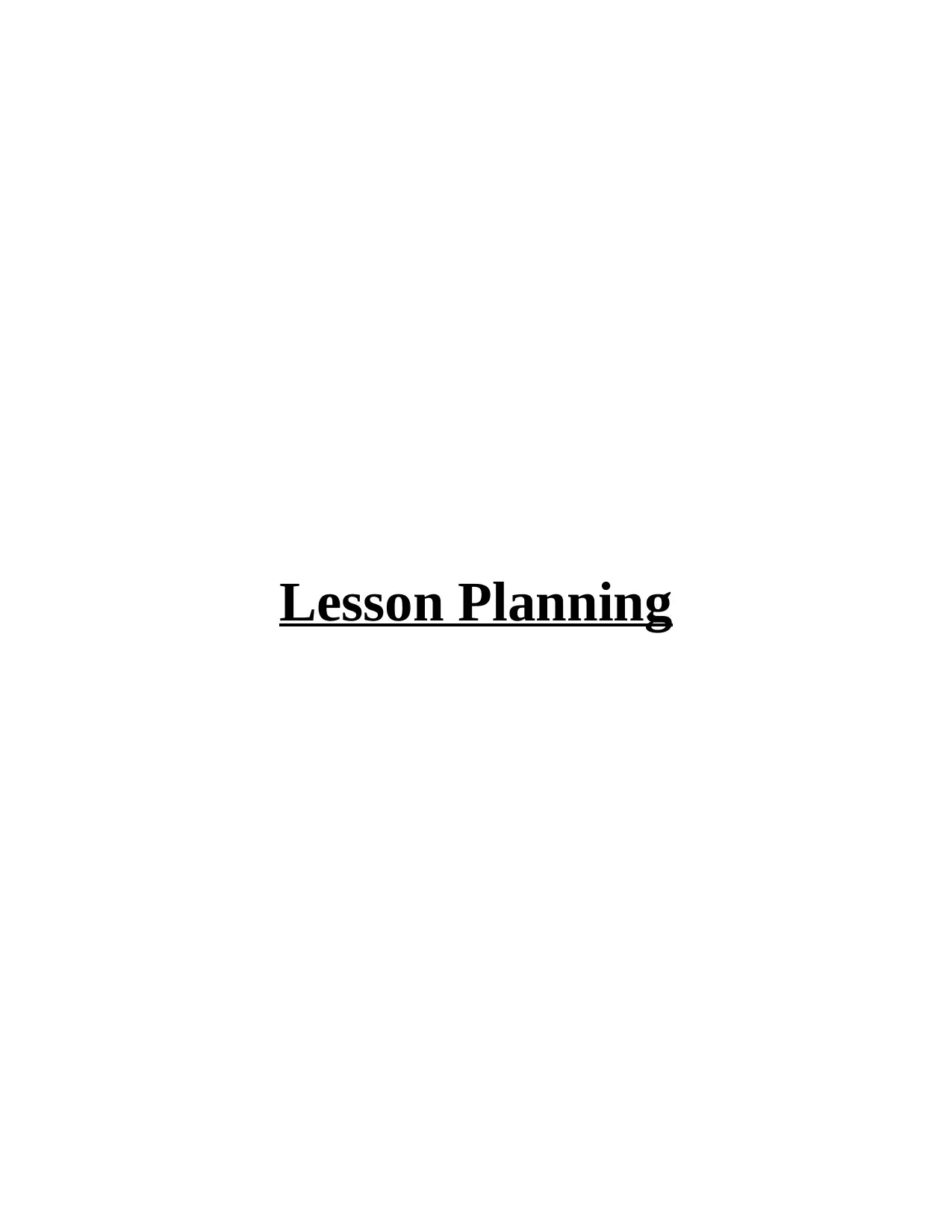
Lesson Planning
Paraphrase This Document
Need a fresh take? Get an instant paraphrase of this document with our AI Paraphraser
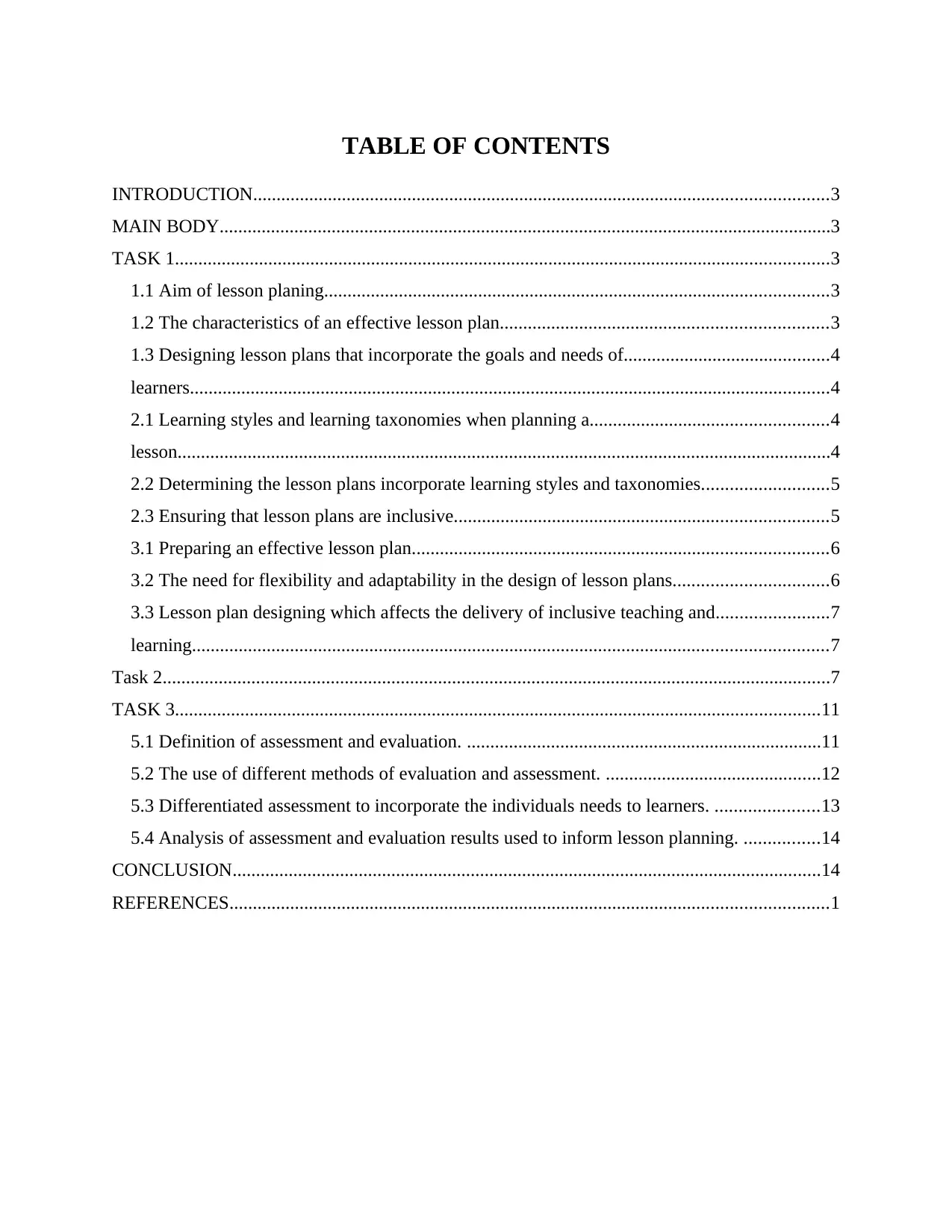
TABLE OF CONTENTS
INTRODUCTION...........................................................................................................................3
MAIN BODY...................................................................................................................................3
TASK 1............................................................................................................................................3
1.1 Aim of lesson planing............................................................................................................3
1.2 The characteristics of an effective lesson plan......................................................................3
1.3 Designing lesson plans that incorporate the goals and needs of............................................4
learners.........................................................................................................................................4
2.1 Learning styles and learning taxonomies when planning a...................................................4
lesson............................................................................................................................................4
2.2 Determining the lesson plans incorporate learning styles and taxonomies...........................5
2.3 Ensuring that lesson plans are inclusive................................................................................5
3.1 Preparing an effective lesson plan.........................................................................................6
3.2 The need for flexibility and adaptability in the design of lesson plans.................................6
3.3 Lesson plan designing which affects the delivery of inclusive teaching and........................7
learning........................................................................................................................................7
Task 2...............................................................................................................................................7
TASK 3..........................................................................................................................................11
5.1 Definition of assessment and evaluation. ............................................................................11
5.2 The use of different methods of evaluation and assessment. ..............................................12
5.3 Differentiated assessment to incorporate the individuals needs to learners. ......................13
5.4 Analysis of assessment and evaluation results used to inform lesson planning. ................14
CONCLUSION..............................................................................................................................14
REFERENCES................................................................................................................................1
INTRODUCTION...........................................................................................................................3
MAIN BODY...................................................................................................................................3
TASK 1............................................................................................................................................3
1.1 Aim of lesson planing............................................................................................................3
1.2 The characteristics of an effective lesson plan......................................................................3
1.3 Designing lesson plans that incorporate the goals and needs of............................................4
learners.........................................................................................................................................4
2.1 Learning styles and learning taxonomies when planning a...................................................4
lesson............................................................................................................................................4
2.2 Determining the lesson plans incorporate learning styles and taxonomies...........................5
2.3 Ensuring that lesson plans are inclusive................................................................................5
3.1 Preparing an effective lesson plan.........................................................................................6
3.2 The need for flexibility and adaptability in the design of lesson plans.................................6
3.3 Lesson plan designing which affects the delivery of inclusive teaching and........................7
learning........................................................................................................................................7
Task 2...............................................................................................................................................7
TASK 3..........................................................................................................................................11
5.1 Definition of assessment and evaluation. ............................................................................11
5.2 The use of different methods of evaluation and assessment. ..............................................12
5.3 Differentiated assessment to incorporate the individuals needs to learners. ......................13
5.4 Analysis of assessment and evaluation results used to inform lesson planning. ................14
CONCLUSION..............................................................................................................................14
REFERENCES................................................................................................................................1
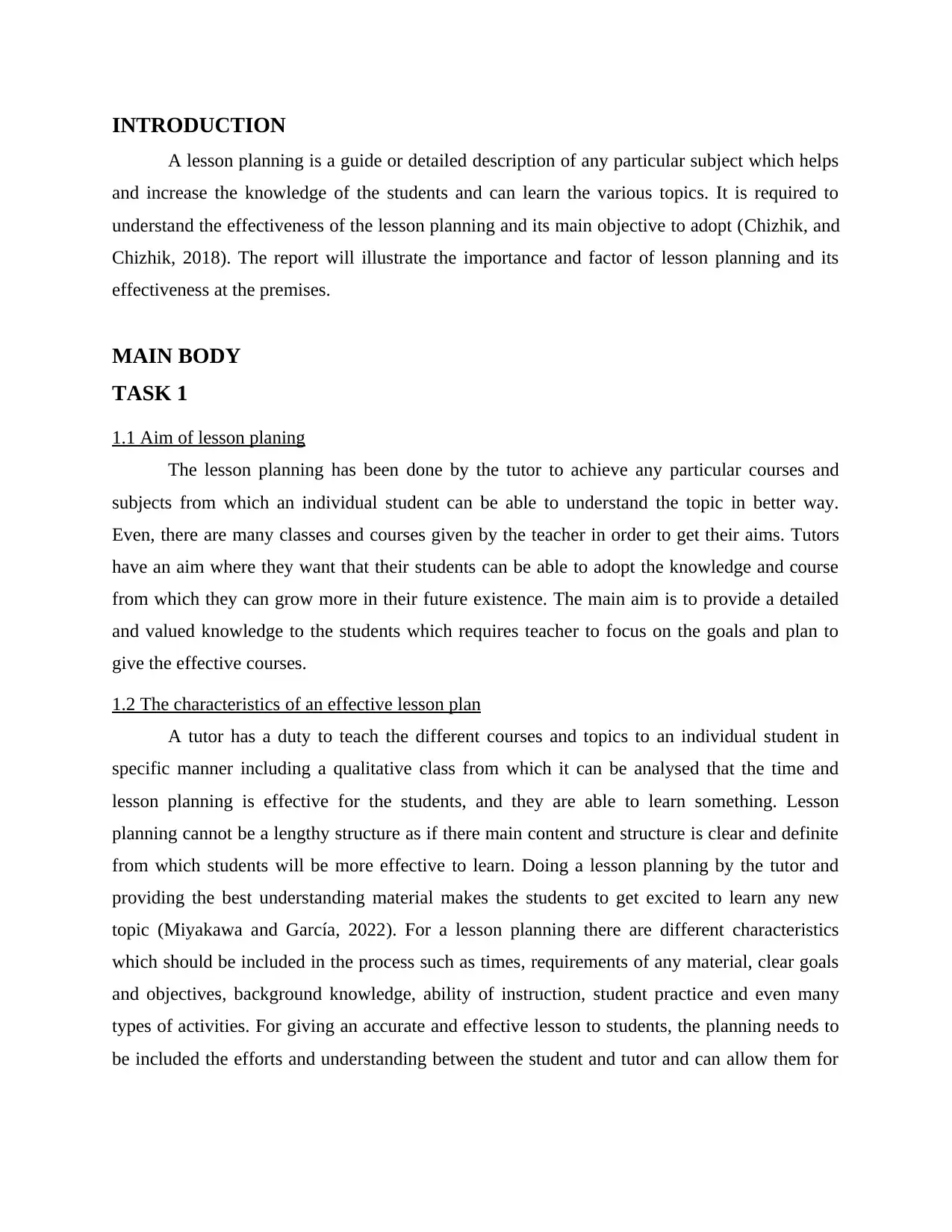
INTRODUCTION
A lesson planning is a guide or detailed description of any particular subject which helps
and increase the knowledge of the students and can learn the various topics. It is required to
understand the effectiveness of the lesson planning and its main objective to adopt (Chizhik, and
Chizhik, 2018). The report will illustrate the importance and factor of lesson planning and its
effectiveness at the premises.
MAIN BODY
TASK 1
1.1 Aim of lesson planing
The lesson planning has been done by the tutor to achieve any particular courses and
subjects from which an individual student can be able to understand the topic in better way.
Even, there are many classes and courses given by the teacher in order to get their aims. Tutors
have an aim where they want that their students can be able to adopt the knowledge and course
from which they can grow more in their future existence. The main aim is to provide a detailed
and valued knowledge to the students which requires teacher to focus on the goals and plan to
give the effective courses.
1.2 The characteristics of an effective lesson plan
A tutor has a duty to teach the different courses and topics to an individual student in
specific manner including a qualitative class from which it can be analysed that the time and
lesson planning is effective for the students, and they are able to learn something. Lesson
planning cannot be a lengthy structure as if there main content and structure is clear and definite
from which students will be more effective to learn. Doing a lesson planning by the tutor and
providing the best understanding material makes the students to get excited to learn any new
topic (Miyakawa and García, 2022). For a lesson planning there are different characteristics
which should be included in the process such as times, requirements of any material, clear goals
and objectives, background knowledge, ability of instruction, student practice and even many
types of activities. For giving an accurate and effective lesson to students, the planning needs to
be included the efforts and understanding between the student and tutor and can allow them for
A lesson planning is a guide or detailed description of any particular subject which helps
and increase the knowledge of the students and can learn the various topics. It is required to
understand the effectiveness of the lesson planning and its main objective to adopt (Chizhik, and
Chizhik, 2018). The report will illustrate the importance and factor of lesson planning and its
effectiveness at the premises.
MAIN BODY
TASK 1
1.1 Aim of lesson planing
The lesson planning has been done by the tutor to achieve any particular courses and
subjects from which an individual student can be able to understand the topic in better way.
Even, there are many classes and courses given by the teacher in order to get their aims. Tutors
have an aim where they want that their students can be able to adopt the knowledge and course
from which they can grow more in their future existence. The main aim is to provide a detailed
and valued knowledge to the students which requires teacher to focus on the goals and plan to
give the effective courses.
1.2 The characteristics of an effective lesson plan
A tutor has a duty to teach the different courses and topics to an individual student in
specific manner including a qualitative class from which it can be analysed that the time and
lesson planning is effective for the students, and they are able to learn something. Lesson
planning cannot be a lengthy structure as if there main content and structure is clear and definite
from which students will be more effective to learn. Doing a lesson planning by the tutor and
providing the best understanding material makes the students to get excited to learn any new
topic (Miyakawa and García, 2022). For a lesson planning there are different characteristics
which should be included in the process such as times, requirements of any material, clear goals
and objectives, background knowledge, ability of instruction, student practice and even many
types of activities. For giving an accurate and effective lesson to students, the planning needs to
be included the efforts and understanding between the student and tutor and can allow them for
⊘ This is a preview!⊘
Do you want full access?
Subscribe today to unlock all pages.

Trusted by 1+ million students worldwide
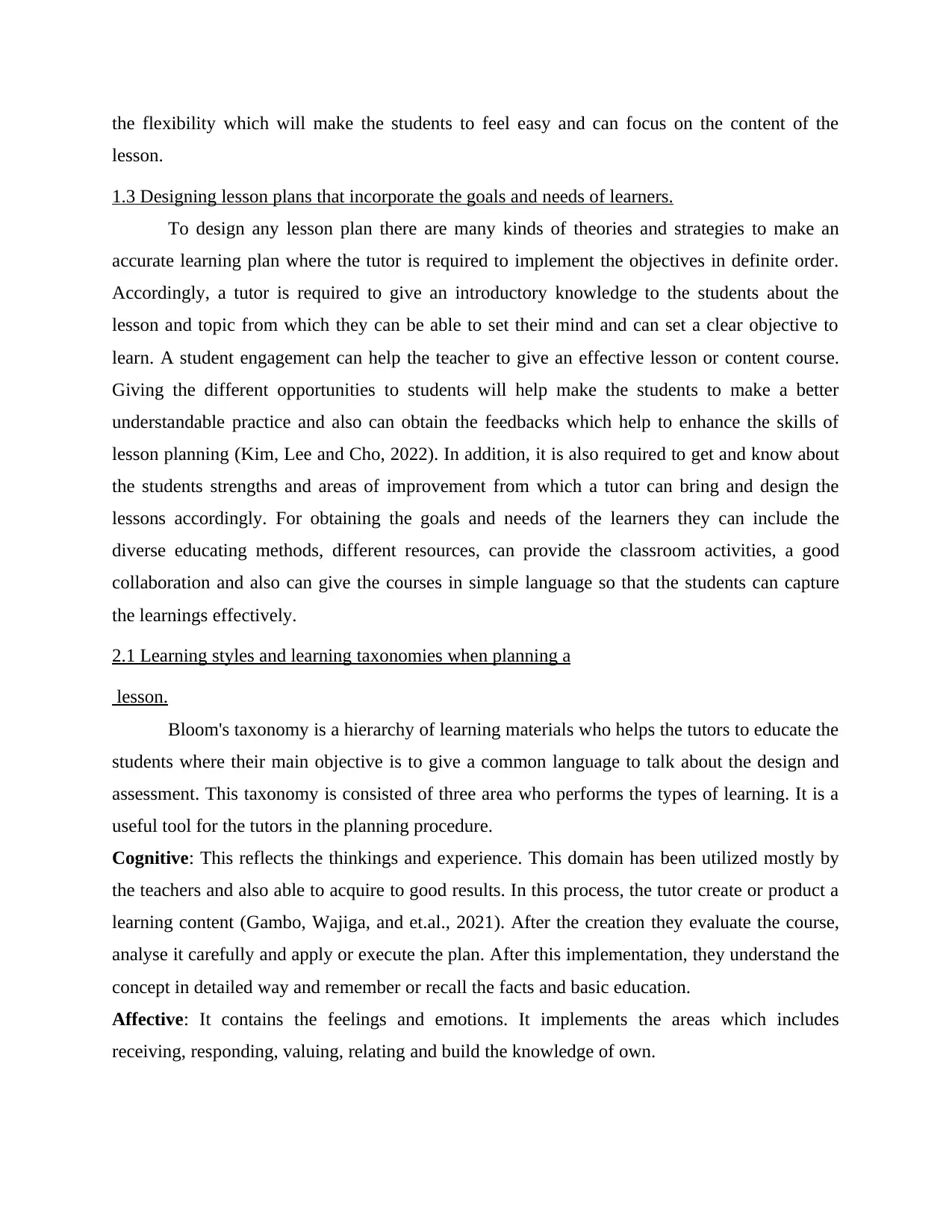
the flexibility which will make the students to feel easy and can focus on the content of the
lesson.
1.3 Designing lesson plans that incorporate the goals and needs of learners.
To design any lesson plan there are many kinds of theories and strategies to make an
accurate learning plan where the tutor is required to implement the objectives in definite order.
Accordingly, a tutor is required to give an introductory knowledge to the students about the
lesson and topic from which they can be able to set their mind and can set a clear objective to
learn. A student engagement can help the teacher to give an effective lesson or content course.
Giving the different opportunities to students will help make the students to make a better
understandable practice and also can obtain the feedbacks which help to enhance the skills of
lesson planning (Kim, Lee and Cho, 2022). In addition, it is also required to get and know about
the students strengths and areas of improvement from which a tutor can bring and design the
lessons accordingly. For obtaining the goals and needs of the learners they can include the
diverse educating methods, different resources, can provide the classroom activities, a good
collaboration and also can give the courses in simple language so that the students can capture
the learnings effectively.
2.1 Learning styles and learning taxonomies when planning a
lesson.
Bloom's taxonomy is a hierarchy of learning materials who helps the tutors to educate the
students where their main objective is to give a common language to talk about the design and
assessment. This taxonomy is consisted of three area who performs the types of learning. It is a
useful tool for the tutors in the planning procedure.
Cognitive: This reflects the thinkings and experience. This domain has been utilized mostly by
the teachers and also able to acquire to good results. In this process, the tutor create or product a
learning content (Gambo, Wajiga, and et.al., 2021). After the creation they evaluate the course,
analyse it carefully and apply or execute the plan. After this implementation, they understand the
concept in detailed way and remember or recall the facts and basic education.
Affective: It contains the feelings and emotions. It implements the areas which includes
receiving, responding, valuing, relating and build the knowledge of own.
lesson.
1.3 Designing lesson plans that incorporate the goals and needs of learners.
To design any lesson plan there are many kinds of theories and strategies to make an
accurate learning plan where the tutor is required to implement the objectives in definite order.
Accordingly, a tutor is required to give an introductory knowledge to the students about the
lesson and topic from which they can be able to set their mind and can set a clear objective to
learn. A student engagement can help the teacher to give an effective lesson or content course.
Giving the different opportunities to students will help make the students to make a better
understandable practice and also can obtain the feedbacks which help to enhance the skills of
lesson planning (Kim, Lee and Cho, 2022). In addition, it is also required to get and know about
the students strengths and areas of improvement from which a tutor can bring and design the
lessons accordingly. For obtaining the goals and needs of the learners they can include the
diverse educating methods, different resources, can provide the classroom activities, a good
collaboration and also can give the courses in simple language so that the students can capture
the learnings effectively.
2.1 Learning styles and learning taxonomies when planning a
lesson.
Bloom's taxonomy is a hierarchy of learning materials who helps the tutors to educate the
students where their main objective is to give a common language to talk about the design and
assessment. This taxonomy is consisted of three area who performs the types of learning. It is a
useful tool for the tutors in the planning procedure.
Cognitive: This reflects the thinkings and experience. This domain has been utilized mostly by
the teachers and also able to acquire to good results. In this process, the tutor create or product a
learning content (Gambo, Wajiga, and et.al., 2021). After the creation they evaluate the course,
analyse it carefully and apply or execute the plan. After this implementation, they understand the
concept in detailed way and remember or recall the facts and basic education.
Affective: It contains the feelings and emotions. It implements the areas which includes
receiving, responding, valuing, relating and build the knowledge of own.
Paraphrase This Document
Need a fresh take? Get an instant paraphrase of this document with our AI Paraphraser
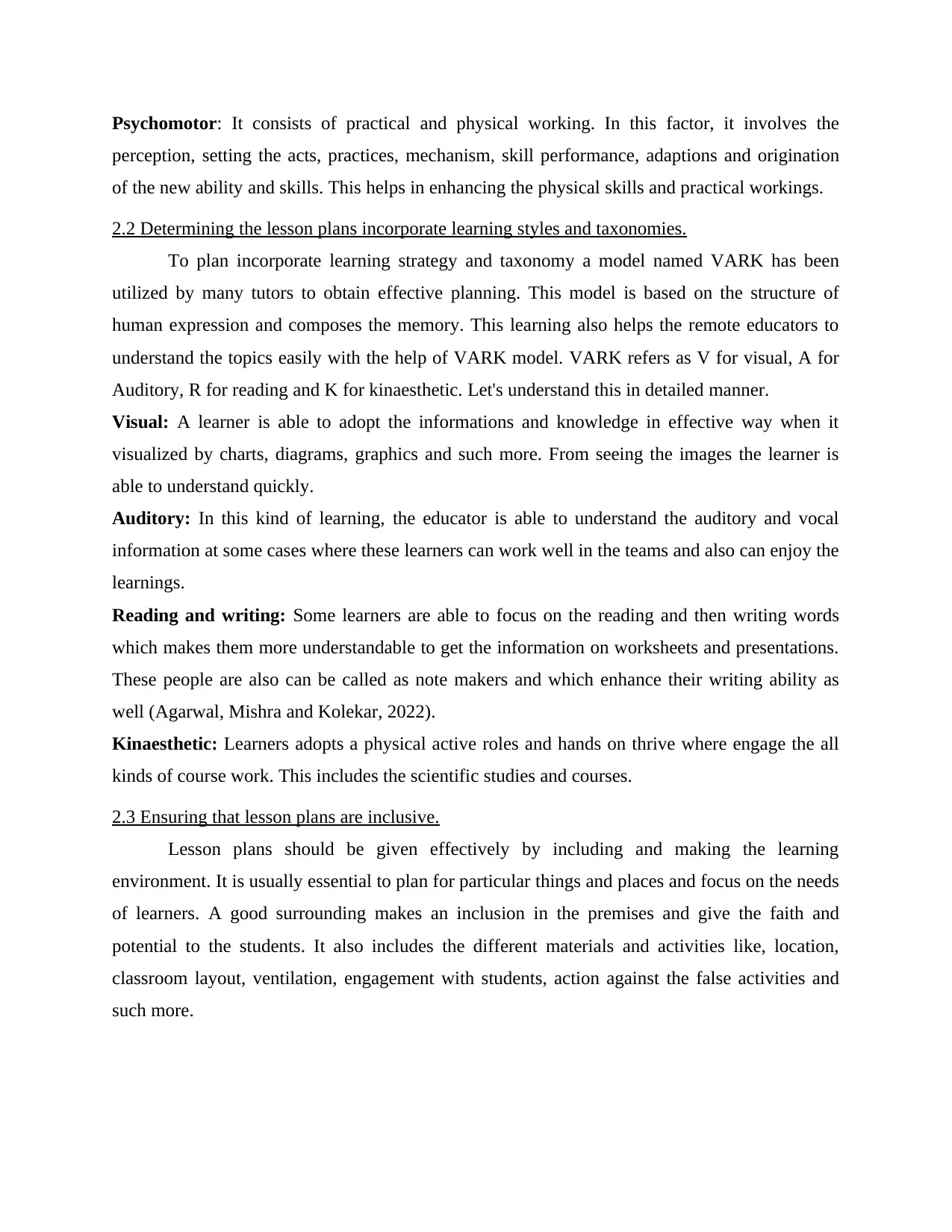
Psychomotor: It consists of practical and physical working. In this factor, it involves the
perception, setting the acts, practices, mechanism, skill performance, adaptions and origination
of the new ability and skills. This helps in enhancing the physical skills and practical workings.
2.2 Determining the lesson plans incorporate learning styles and taxonomies.
To plan incorporate learning strategy and taxonomy a model named VARK has been
utilized by many tutors to obtain effective planning. This model is based on the structure of
human expression and composes the memory. This learning also helps the remote educators to
understand the topics easily with the help of VARK model. VARK refers as V for visual, A for
Auditory, R for reading and K for kinaesthetic. Let's understand this in detailed manner.
Visual: A learner is able to adopt the informations and knowledge in effective way when it
visualized by charts, diagrams, graphics and such more. From seeing the images the learner is
able to understand quickly.
Auditory: In this kind of learning, the educator is able to understand the auditory and vocal
information at some cases where these learners can work well in the teams and also can enjoy the
learnings.
Reading and writing: Some learners are able to focus on the reading and then writing words
which makes them more understandable to get the information on worksheets and presentations.
These people are also can be called as note makers and which enhance their writing ability as
well (Agarwal, Mishra and Kolekar, 2022).
Kinaesthetic: Learners adopts a physical active roles and hands on thrive where engage the all
kinds of course work. This includes the scientific studies and courses.
2.3 Ensuring that lesson plans are inclusive.
Lesson plans should be given effectively by including and making the learning
environment. It is usually essential to plan for particular things and places and focus on the needs
of learners. A good surrounding makes an inclusion in the premises and give the faith and
potential to the students. It also includes the different materials and activities like, location,
classroom layout, ventilation, engagement with students, action against the false activities and
such more.
perception, setting the acts, practices, mechanism, skill performance, adaptions and origination
of the new ability and skills. This helps in enhancing the physical skills and practical workings.
2.2 Determining the lesson plans incorporate learning styles and taxonomies.
To plan incorporate learning strategy and taxonomy a model named VARK has been
utilized by many tutors to obtain effective planning. This model is based on the structure of
human expression and composes the memory. This learning also helps the remote educators to
understand the topics easily with the help of VARK model. VARK refers as V for visual, A for
Auditory, R for reading and K for kinaesthetic. Let's understand this in detailed manner.
Visual: A learner is able to adopt the informations and knowledge in effective way when it
visualized by charts, diagrams, graphics and such more. From seeing the images the learner is
able to understand quickly.
Auditory: In this kind of learning, the educator is able to understand the auditory and vocal
information at some cases where these learners can work well in the teams and also can enjoy the
learnings.
Reading and writing: Some learners are able to focus on the reading and then writing words
which makes them more understandable to get the information on worksheets and presentations.
These people are also can be called as note makers and which enhance their writing ability as
well (Agarwal, Mishra and Kolekar, 2022).
Kinaesthetic: Learners adopts a physical active roles and hands on thrive where engage the all
kinds of course work. This includes the scientific studies and courses.
2.3 Ensuring that lesson plans are inclusive.
Lesson plans should be given effectively by including and making the learning
environment. It is usually essential to plan for particular things and places and focus on the needs
of learners. A good surrounding makes an inclusion in the premises and give the faith and
potential to the students. It also includes the different materials and activities like, location,
classroom layout, ventilation, engagement with students, action against the false activities and
such more.
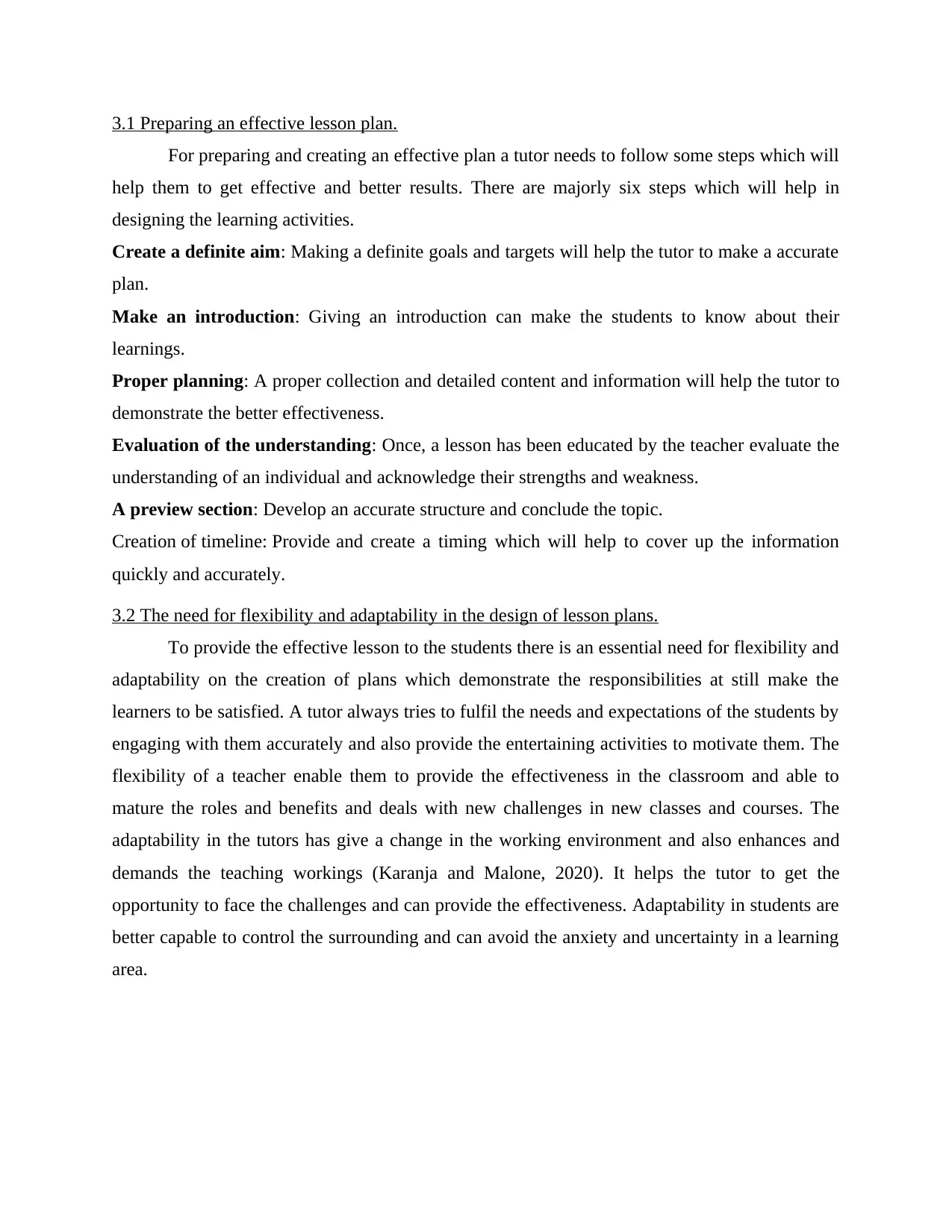
3.1 Preparing an effective lesson plan.
For preparing and creating an effective plan a tutor needs to follow some steps which will
help them to get effective and better results. There are majorly six steps which will help in
designing the learning activities.
Create a definite aim: Making a definite goals and targets will help the tutor to make a accurate
plan.
Make an introduction: Giving an introduction can make the students to know about their
learnings.
Proper planning: A proper collection and detailed content and information will help the tutor to
demonstrate the better effectiveness.
Evaluation of the understanding: Once, a lesson has been educated by the teacher evaluate the
understanding of an individual and acknowledge their strengths and weakness.
A preview section: Develop an accurate structure and conclude the topic.
Creation of timeline: Provide and create a timing which will help to cover up the information
quickly and accurately.
3.2 The need for flexibility and adaptability in the design of lesson plans.
To provide the effective lesson to the students there is an essential need for flexibility and
adaptability on the creation of plans which demonstrate the responsibilities at still make the
learners to be satisfied. A tutor always tries to fulfil the needs and expectations of the students by
engaging with them accurately and also provide the entertaining activities to motivate them. The
flexibility of a teacher enable them to provide the effectiveness in the classroom and able to
mature the roles and benefits and deals with new challenges in new classes and courses. The
adaptability in the tutors has give a change in the working environment and also enhances and
demands the teaching workings (Karanja and Malone, 2020). It helps the tutor to get the
opportunity to face the challenges and can provide the effectiveness. Adaptability in students are
better capable to control the surrounding and can avoid the anxiety and uncertainty in a learning
area.
For preparing and creating an effective plan a tutor needs to follow some steps which will
help them to get effective and better results. There are majorly six steps which will help in
designing the learning activities.
Create a definite aim: Making a definite goals and targets will help the tutor to make a accurate
plan.
Make an introduction: Giving an introduction can make the students to know about their
learnings.
Proper planning: A proper collection and detailed content and information will help the tutor to
demonstrate the better effectiveness.
Evaluation of the understanding: Once, a lesson has been educated by the teacher evaluate the
understanding of an individual and acknowledge their strengths and weakness.
A preview section: Develop an accurate structure and conclude the topic.
Creation of timeline: Provide and create a timing which will help to cover up the information
quickly and accurately.
3.2 The need for flexibility and adaptability in the design of lesson plans.
To provide the effective lesson to the students there is an essential need for flexibility and
adaptability on the creation of plans which demonstrate the responsibilities at still make the
learners to be satisfied. A tutor always tries to fulfil the needs and expectations of the students by
engaging with them accurately and also provide the entertaining activities to motivate them. The
flexibility of a teacher enable them to provide the effectiveness in the classroom and able to
mature the roles and benefits and deals with new challenges in new classes and courses. The
adaptability in the tutors has give a change in the working environment and also enhances and
demands the teaching workings (Karanja and Malone, 2020). It helps the tutor to get the
opportunity to face the challenges and can provide the effectiveness. Adaptability in students are
better capable to control the surrounding and can avoid the anxiety and uncertainty in a learning
area.
⊘ This is a preview!⊘
Do you want full access?
Subscribe today to unlock all pages.

Trusted by 1+ million students worldwide
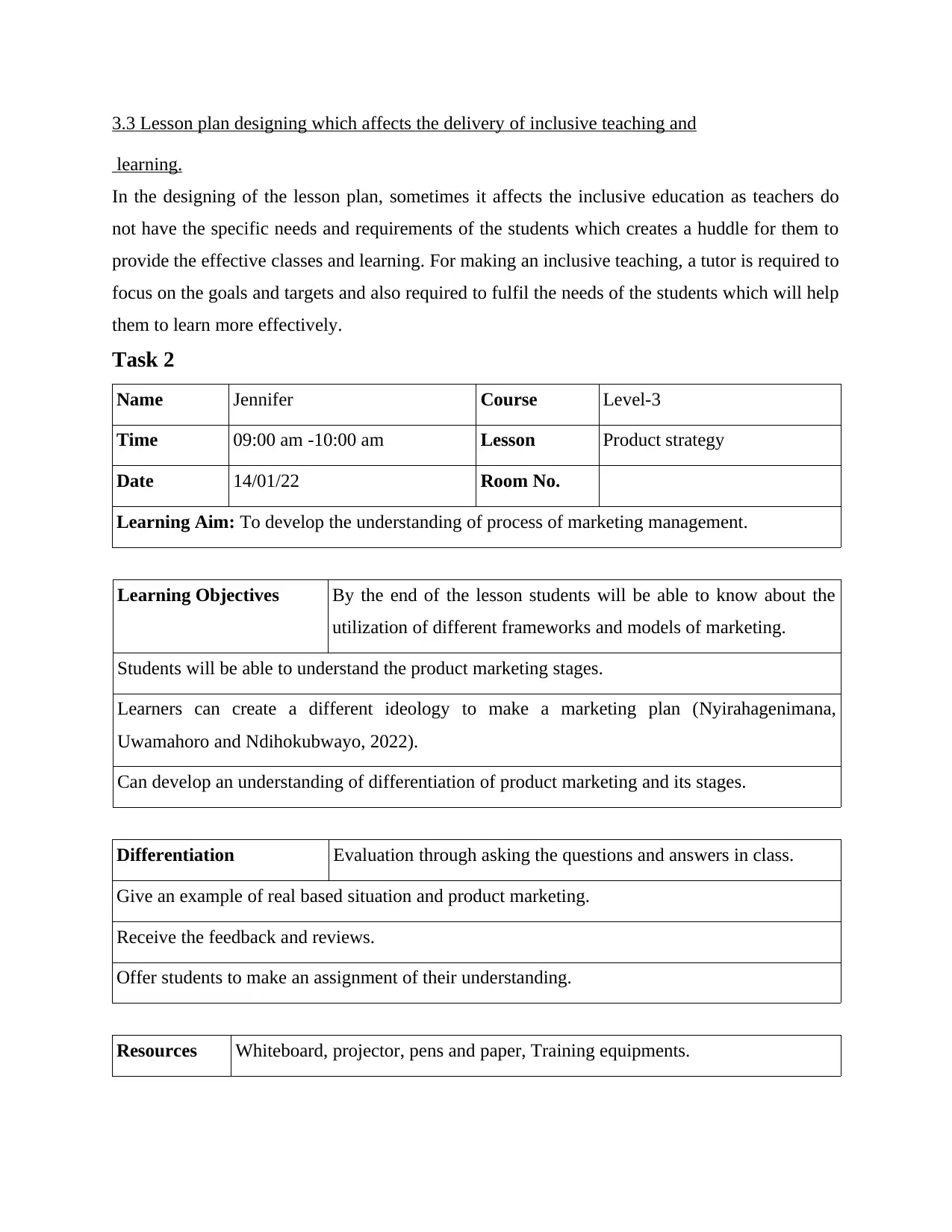
3.3 Lesson plan designing which affects the delivery of inclusive teaching and
learning.
In the designing of the lesson plan, sometimes it affects the inclusive education as teachers do
not have the specific needs and requirements of the students which creates a huddle for them to
provide the effective classes and learning. For making an inclusive teaching, a tutor is required to
focus on the goals and targets and also required to fulfil the needs of the students which will help
them to learn more effectively.
Task 2
Name Jennifer Course Level-3
Time 09:00 am -10:00 am Lesson Product strategy
Date 14/01/22 Room No.
Learning Aim: To develop the understanding of process of marketing management.
Learning Objectives By the end of the lesson students will be able to know about the
utilization of different frameworks and models of marketing.
Students will be able to understand the product marketing stages.
Learners can create a different ideology to make a marketing plan (Nyirahagenimana,
Uwamahoro and Ndihokubwayo, 2022).
Can develop an understanding of differentiation of product marketing and its stages.
Differentiation Evaluation through asking the questions and answers in class.
Give an example of real based situation and product marketing.
Receive the feedback and reviews.
Offer students to make an assignment of their understanding.
Resources Whiteboard, projector, pens and paper, Training equipments.
learning.
In the designing of the lesson plan, sometimes it affects the inclusive education as teachers do
not have the specific needs and requirements of the students which creates a huddle for them to
provide the effective classes and learning. For making an inclusive teaching, a tutor is required to
focus on the goals and targets and also required to fulfil the needs of the students which will help
them to learn more effectively.
Task 2
Name Jennifer Course Level-3
Time 09:00 am -10:00 am Lesson Product strategy
Date 14/01/22 Room No.
Learning Aim: To develop the understanding of process of marketing management.
Learning Objectives By the end of the lesson students will be able to know about the
utilization of different frameworks and models of marketing.
Students will be able to understand the product marketing stages.
Learners can create a different ideology to make a marketing plan (Nyirahagenimana,
Uwamahoro and Ndihokubwayo, 2022).
Can develop an understanding of differentiation of product marketing and its stages.
Differentiation Evaluation through asking the questions and answers in class.
Give an example of real based situation and product marketing.
Receive the feedback and reviews.
Offer students to make an assignment of their understanding.
Resources Whiteboard, projector, pens and paper, Training equipments.
Paraphrase This Document
Need a fresh take? Get an instant paraphrase of this document with our AI Paraphraser
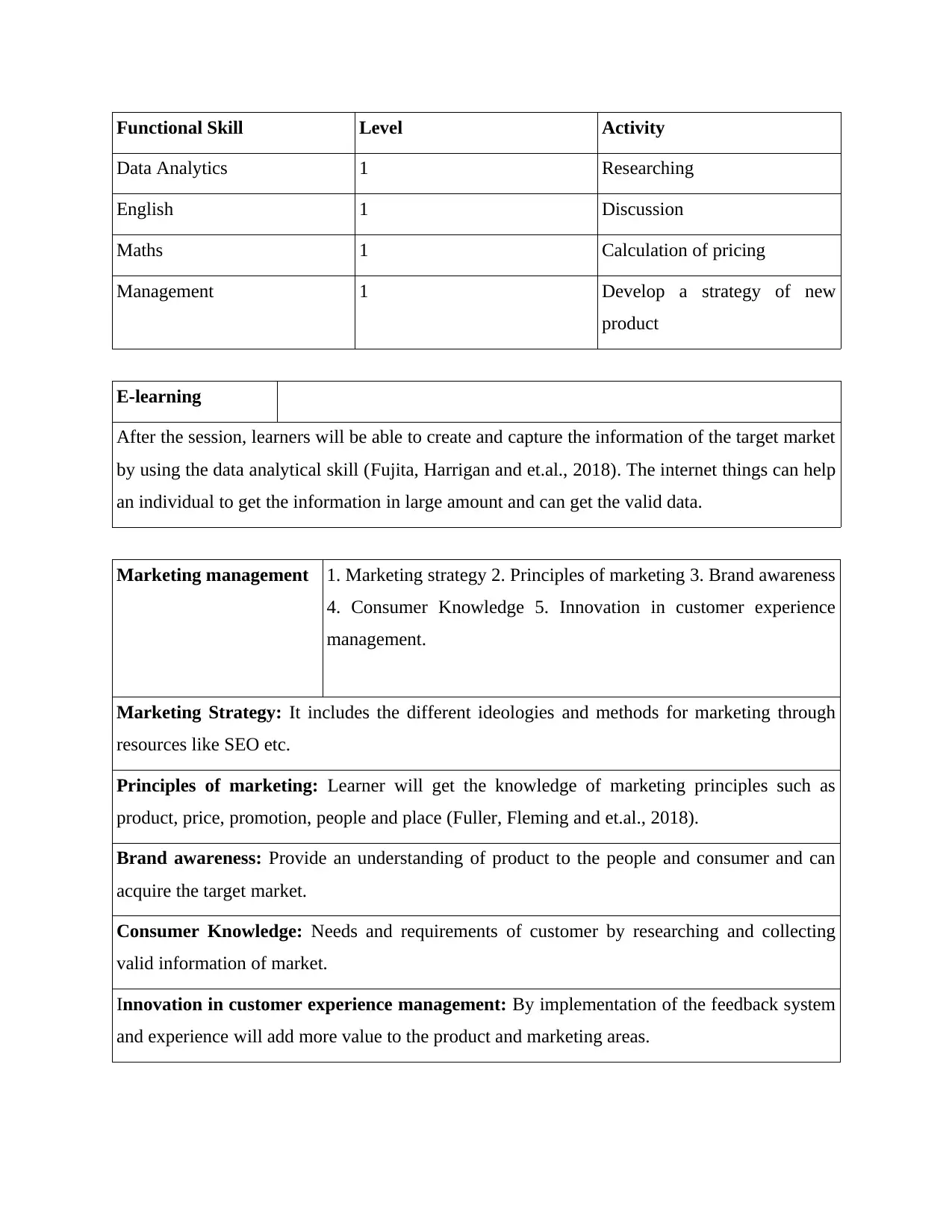
Functional Skill Level Activity
Data Analytics 1 Researching
English 1 Discussion
Maths 1 Calculation of pricing
Management 1 Develop a strategy of new
product
E-learning
After the session, learners will be able to create and capture the information of the target market
by using the data analytical skill (Fujita, Harrigan and et.al., 2018). The internet things can help
an individual to get the information in large amount and can get the valid data.
Marketing management 1. Marketing strategy 2. Principles of marketing 3. Brand awareness
4. Consumer Knowledge 5. Innovation in customer experience
management.
Marketing Strategy: It includes the different ideologies and methods for marketing through
resources like SEO etc.
Principles of marketing: Learner will get the knowledge of marketing principles such as
product, price, promotion, people and place (Fuller, Fleming and et.al., 2018).
Brand awareness: Provide an understanding of product to the people and consumer and can
acquire the target market.
Consumer Knowledge: Needs and requirements of customer by researching and collecting
valid information of market.
Innovation in customer experience management: By implementation of the feedback system
and experience will add more value to the product and marketing areas.
Data Analytics 1 Researching
English 1 Discussion
Maths 1 Calculation of pricing
Management 1 Develop a strategy of new
product
E-learning
After the session, learners will be able to create and capture the information of the target market
by using the data analytical skill (Fujita, Harrigan and et.al., 2018). The internet things can help
an individual to get the information in large amount and can get the valid data.
Marketing management 1. Marketing strategy 2. Principles of marketing 3. Brand awareness
4. Consumer Knowledge 5. Innovation in customer experience
management.
Marketing Strategy: It includes the different ideologies and methods for marketing through
resources like SEO etc.
Principles of marketing: Learner will get the knowledge of marketing principles such as
product, price, promotion, people and place (Fuller, Fleming and et.al., 2018).
Brand awareness: Provide an understanding of product to the people and consumer and can
acquire the target market.
Consumer Knowledge: Needs and requirements of customer by researching and collecting
valid information of market.
Innovation in customer experience management: By implementation of the feedback system
and experience will add more value to the product and marketing areas.
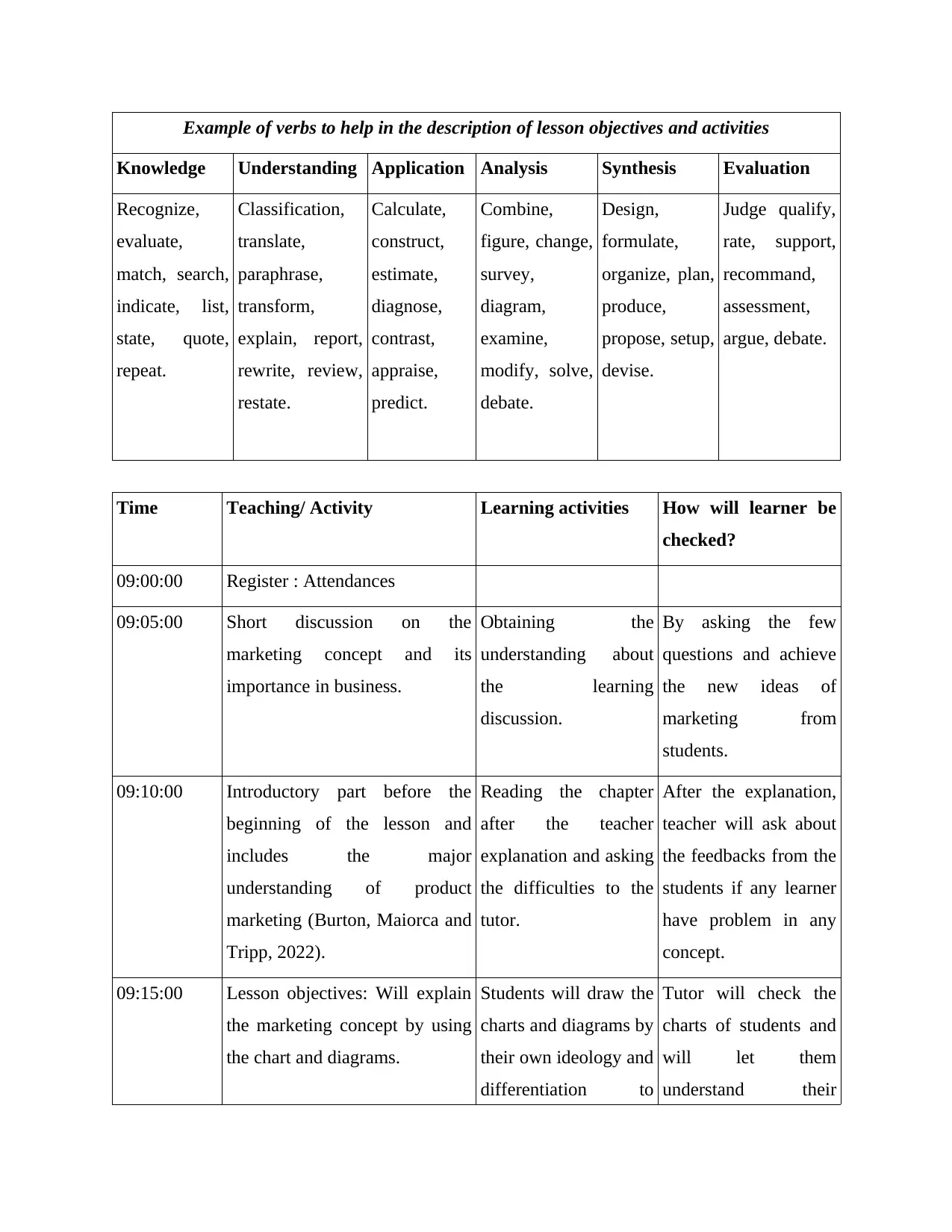
Example of verbs to help in the description of lesson objectives and activities
Knowledge Understanding Application Analysis Synthesis Evaluation
Recognize,
evaluate,
match, search,
indicate, list,
state, quote,
repeat.
Classification,
translate,
paraphrase,
transform,
explain, report,
rewrite, review,
restate.
Calculate,
construct,
estimate,
diagnose,
contrast,
appraise,
predict.
Combine,
figure, change,
survey,
diagram,
examine,
modify, solve,
debate.
Design,
formulate,
organize, plan,
produce,
propose, setup,
devise.
Judge qualify,
rate, support,
recommand,
assessment,
argue, debate.
Time Teaching/ Activity Learning activities How will learner be
checked?
09:00:00 Register : Attendances
09:05:00 Short discussion on the
marketing concept and its
importance in business.
Obtaining the
understanding about
the learning
discussion.
By asking the few
questions and achieve
the new ideas of
marketing from
students.
09:10:00 Introductory part before the
beginning of the lesson and
includes the major
understanding of product
marketing (Burton, Maiorca and
Tripp, 2022).
Reading the chapter
after the teacher
explanation and asking
the difficulties to the
tutor.
After the explanation,
teacher will ask about
the feedbacks from the
students if any learner
have problem in any
concept.
09:15:00 Lesson objectives: Will explain
the marketing concept by using
the chart and diagrams.
Students will draw the
charts and diagrams by
their own ideology and
differentiation to
Tutor will check the
charts of students and
will let them
understand their
Knowledge Understanding Application Analysis Synthesis Evaluation
Recognize,
evaluate,
match, search,
indicate, list,
state, quote,
repeat.
Classification,
translate,
paraphrase,
transform,
explain, report,
rewrite, review,
restate.
Calculate,
construct,
estimate,
diagnose,
contrast,
appraise,
predict.
Combine,
figure, change,
survey,
diagram,
examine,
modify, solve,
debate.
Design,
formulate,
organize, plan,
produce,
propose, setup,
devise.
Judge qualify,
rate, support,
recommand,
assessment,
argue, debate.
Time Teaching/ Activity Learning activities How will learner be
checked?
09:00:00 Register : Attendances
09:05:00 Short discussion on the
marketing concept and its
importance in business.
Obtaining the
understanding about
the learning
discussion.
By asking the few
questions and achieve
the new ideas of
marketing from
students.
09:10:00 Introductory part before the
beginning of the lesson and
includes the major
understanding of product
marketing (Burton, Maiorca and
Tripp, 2022).
Reading the chapter
after the teacher
explanation and asking
the difficulties to the
tutor.
After the explanation,
teacher will ask about
the feedbacks from the
students if any learner
have problem in any
concept.
09:15:00 Lesson objectives: Will explain
the marketing concept by using
the chart and diagrams.
Students will draw the
charts and diagrams by
their own ideology and
differentiation to
Tutor will check the
charts of students and
will let them
understand their
⊘ This is a preview!⊘
Do you want full access?
Subscribe today to unlock all pages.

Trusted by 1+ million students worldwide
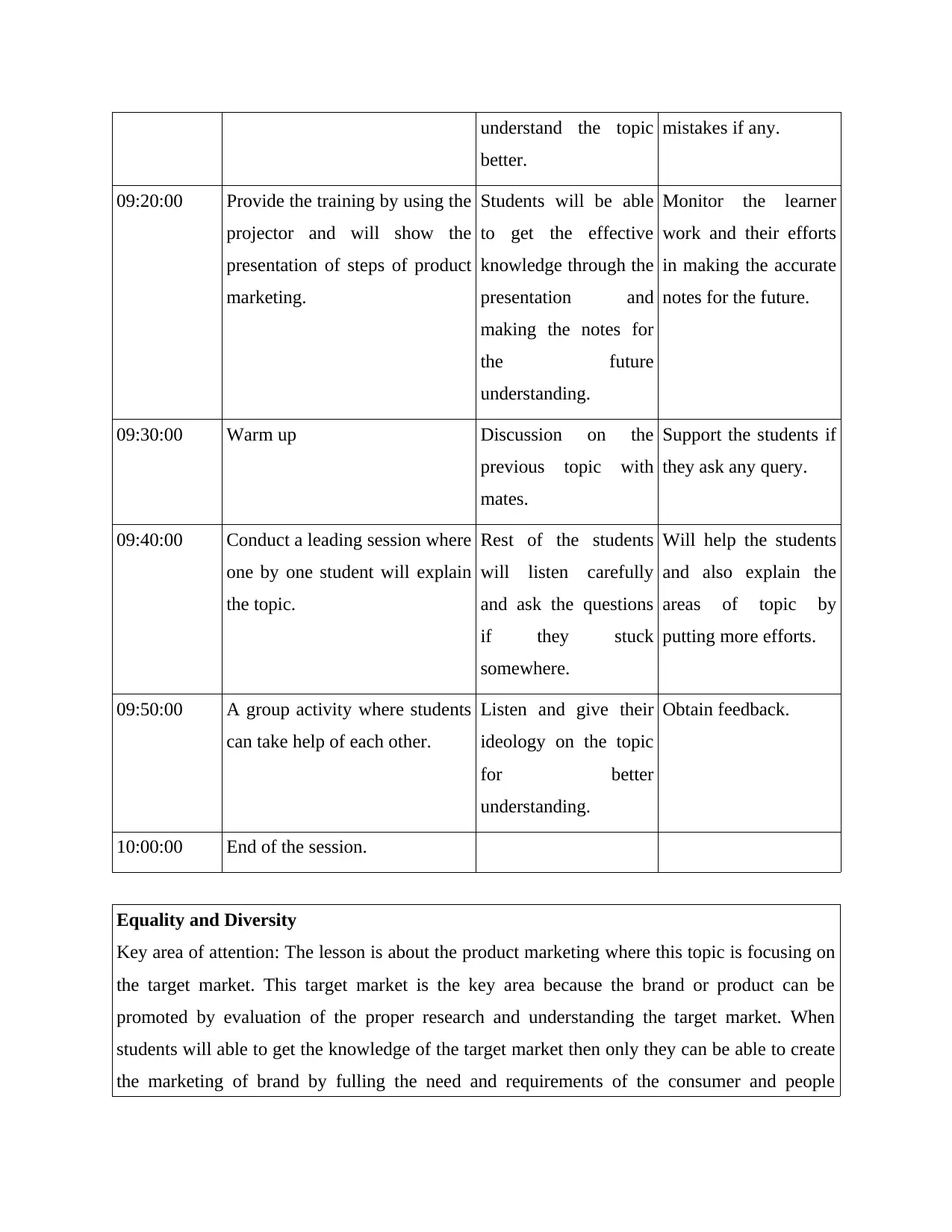
understand the topic
better.
mistakes if any.
09:20:00 Provide the training by using the
projector and will show the
presentation of steps of product
marketing.
Students will be able
to get the effective
knowledge through the
presentation and
making the notes for
the future
understanding.
Monitor the learner
work and their efforts
in making the accurate
notes for the future.
09:30:00 Warm up Discussion on the
previous topic with
mates.
Support the students if
they ask any query.
09:40:00 Conduct a leading session where
one by one student will explain
the topic.
Rest of the students
will listen carefully
and ask the questions
if they stuck
somewhere.
Will help the students
and also explain the
areas of topic by
putting more efforts.
09:50:00 A group activity where students
can take help of each other.
Listen and give their
ideology on the topic
for better
understanding.
Obtain feedback.
10:00:00 End of the session.
Equality and Diversity
Key area of attention: The lesson is about the product marketing where this topic is focusing on
the target market. This target market is the key area because the brand or product can be
promoted by evaluation of the proper research and understanding the target market. When
students will able to get the knowledge of the target market then only they can be able to create
the marketing of brand by fulling the need and requirements of the consumer and people
better.
mistakes if any.
09:20:00 Provide the training by using the
projector and will show the
presentation of steps of product
marketing.
Students will be able
to get the effective
knowledge through the
presentation and
making the notes for
the future
understanding.
Monitor the learner
work and their efforts
in making the accurate
notes for the future.
09:30:00 Warm up Discussion on the
previous topic with
mates.
Support the students if
they ask any query.
09:40:00 Conduct a leading session where
one by one student will explain
the topic.
Rest of the students
will listen carefully
and ask the questions
if they stuck
somewhere.
Will help the students
and also explain the
areas of topic by
putting more efforts.
09:50:00 A group activity where students
can take help of each other.
Listen and give their
ideology on the topic
for better
understanding.
Obtain feedback.
10:00:00 End of the session.
Equality and Diversity
Key area of attention: The lesson is about the product marketing where this topic is focusing on
the target market. This target market is the key area because the brand or product can be
promoted by evaluation of the proper research and understanding the target market. When
students will able to get the knowledge of the target market then only they can be able to create
the marketing of brand by fulling the need and requirements of the consumer and people
Paraphrase This Document
Need a fresh take? Get an instant paraphrase of this document with our AI Paraphraser
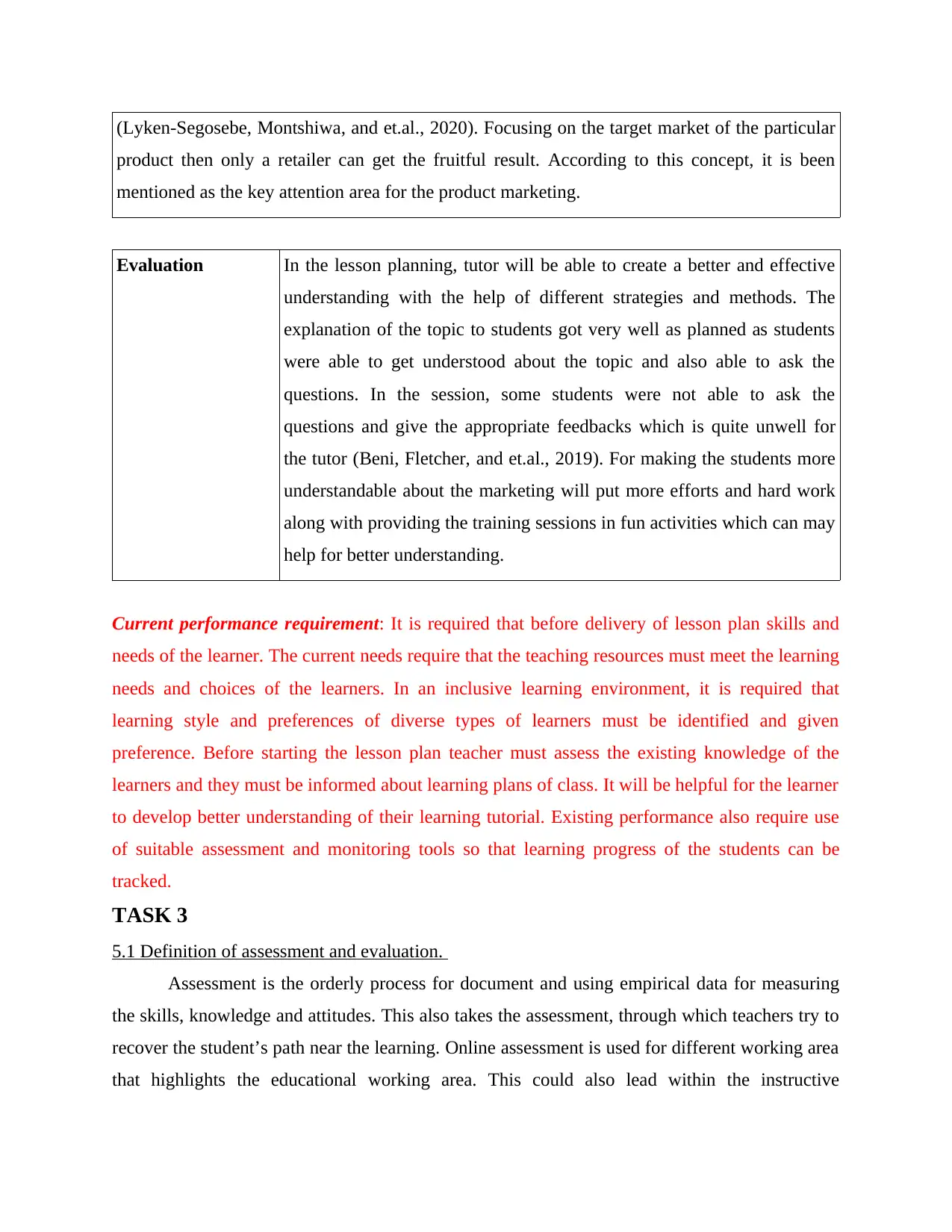
(Lyken-Segosebe, Montshiwa, and et.al., 2020). Focusing on the target market of the particular
product then only a retailer can get the fruitful result. According to this concept, it is been
mentioned as the key attention area for the product marketing.
Evaluation In the lesson planning, tutor will be able to create a better and effective
understanding with the help of different strategies and methods. The
explanation of the topic to students got very well as planned as students
were able to get understood about the topic and also able to ask the
questions. In the session, some students were not able to ask the
questions and give the appropriate feedbacks which is quite unwell for
the tutor (Beni, Fletcher, and et.al., 2019). For making the students more
understandable about the marketing will put more efforts and hard work
along with providing the training sessions in fun activities which can may
help for better understanding.
Current performance requirement: It is required that before delivery of lesson plan skills and
needs of the learner. The current needs require that the teaching resources must meet the learning
needs and choices of the learners. In an inclusive learning environment, it is required that
learning style and preferences of diverse types of learners must be identified and given
preference. Before starting the lesson plan teacher must assess the existing knowledge of the
learners and they must be informed about learning plans of class. It will be helpful for the learner
to develop better understanding of their learning tutorial. Existing performance also require use
of suitable assessment and monitoring tools so that learning progress of the students can be
tracked.
TASK 3
5.1 Definition of assessment and evaluation.
Assessment is the orderly process for document and using empirical data for measuring
the skills, knowledge and attitudes. This also takes the assessment, through which teachers try to
recover the student’s path near the learning. Online assessment is used for different working area
that highlights the educational working area. This could also lead within the instructive
product then only a retailer can get the fruitful result. According to this concept, it is been
mentioned as the key attention area for the product marketing.
Evaluation In the lesson planning, tutor will be able to create a better and effective
understanding with the help of different strategies and methods. The
explanation of the topic to students got very well as planned as students
were able to get understood about the topic and also able to ask the
questions. In the session, some students were not able to ask the
questions and give the appropriate feedbacks which is quite unwell for
the tutor (Beni, Fletcher, and et.al., 2019). For making the students more
understandable about the marketing will put more efforts and hard work
along with providing the training sessions in fun activities which can may
help for better understanding.
Current performance requirement: It is required that before delivery of lesson plan skills and
needs of the learner. The current needs require that the teaching resources must meet the learning
needs and choices of the learners. In an inclusive learning environment, it is required that
learning style and preferences of diverse types of learners must be identified and given
preference. Before starting the lesson plan teacher must assess the existing knowledge of the
learners and they must be informed about learning plans of class. It will be helpful for the learner
to develop better understanding of their learning tutorial. Existing performance also require use
of suitable assessment and monitoring tools so that learning progress of the students can be
tracked.
TASK 3
5.1 Definition of assessment and evaluation.
Assessment is the orderly process for document and using empirical data for measuring
the skills, knowledge and attitudes. This also takes the assessment, through which teachers try to
recover the student’s path near the learning. Online assessment is used for different working area
that highlights the educational working area. This could also lead within the instructive
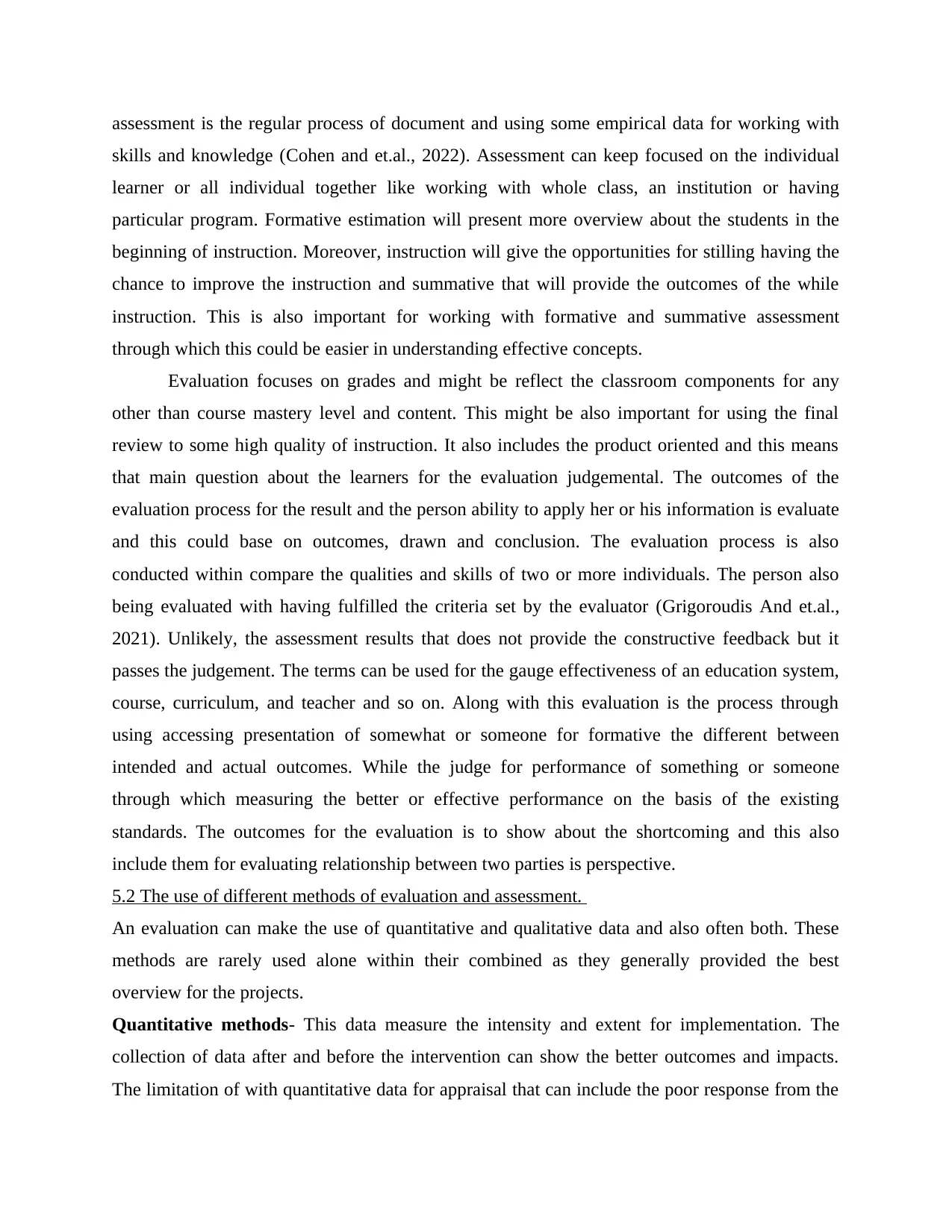
assessment is the regular process of document and using some empirical data for working with
skills and knowledge (Cohen and et.al., 2022). Assessment can keep focused on the individual
learner or all individual together like working with whole class, an institution or having
particular program. Formative estimation will present more overview about the students in the
beginning of instruction. Moreover, instruction will give the opportunities for stilling having the
chance to improve the instruction and summative that will provide the outcomes of the while
instruction. This is also important for working with formative and summative assessment
through which this could be easier in understanding effective concepts.
Evaluation focuses on grades and might be reflect the classroom components for any
other than course mastery level and content. This might be also important for using the final
review to some high quality of instruction. It also includes the product oriented and this means
that main question about the learners for the evaluation judgemental. The outcomes of the
evaluation process for the result and the person ability to apply her or his information is evaluate
and this could base on outcomes, drawn and conclusion. The evaluation process is also
conducted within compare the qualities and skills of two or more individuals. The person also
being evaluated with having fulfilled the criteria set by the evaluator (Grigoroudis And et.al.,
2021). Unlikely, the assessment results that does not provide the constructive feedback but it
passes the judgement. The terms can be used for the gauge effectiveness of an education system,
course, curriculum, and teacher and so on. Along with this evaluation is the process through
using accessing presentation of somewhat or someone for formative the different between
intended and actual outcomes. While the judge for performance of something or someone
through which measuring the better or effective performance on the basis of the existing
standards. The outcomes for the evaluation is to show about the shortcoming and this also
include them for evaluating relationship between two parties is perspective.
5.2 The use of different methods of evaluation and assessment.
An evaluation can make the use of quantitative and qualitative data and also often both. These
methods are rarely used alone within their combined as they generally provided the best
overview for the projects.
Quantitative methods- This data measure the intensity and extent for implementation. The
collection of data after and before the intervention can show the better outcomes and impacts.
The limitation of with quantitative data for appraisal that can include the poor response from the
skills and knowledge (Cohen and et.al., 2022). Assessment can keep focused on the individual
learner or all individual together like working with whole class, an institution or having
particular program. Formative estimation will present more overview about the students in the
beginning of instruction. Moreover, instruction will give the opportunities for stilling having the
chance to improve the instruction and summative that will provide the outcomes of the while
instruction. This is also important for working with formative and summative assessment
through which this could be easier in understanding effective concepts.
Evaluation focuses on grades and might be reflect the classroom components for any
other than course mastery level and content. This might be also important for using the final
review to some high quality of instruction. It also includes the product oriented and this means
that main question about the learners for the evaluation judgemental. The outcomes of the
evaluation process for the result and the person ability to apply her or his information is evaluate
and this could base on outcomes, drawn and conclusion. The evaluation process is also
conducted within compare the qualities and skills of two or more individuals. The person also
being evaluated with having fulfilled the criteria set by the evaluator (Grigoroudis And et.al.,
2021). Unlikely, the assessment results that does not provide the constructive feedback but it
passes the judgement. The terms can be used for the gauge effectiveness of an education system,
course, curriculum, and teacher and so on. Along with this evaluation is the process through
using accessing presentation of somewhat or someone for formative the different between
intended and actual outcomes. While the judge for performance of something or someone
through which measuring the better or effective performance on the basis of the existing
standards. The outcomes for the evaluation is to show about the shortcoming and this also
include them for evaluating relationship between two parties is perspective.
5.2 The use of different methods of evaluation and assessment.
An evaluation can make the use of quantitative and qualitative data and also often both. These
methods are rarely used alone within their combined as they generally provided the best
overview for the projects.
Quantitative methods- This data measure the intensity and extent for implementation. The
collection of data after and before the intervention can show the better outcomes and impacts.
The limitation of with quantitative data for appraisal that can include the poor response from the
⊘ This is a preview!⊘
Do you want full access?
Subscribe today to unlock all pages.

Trusted by 1+ million students worldwide
1 out of 17
Related Documents
Your All-in-One AI-Powered Toolkit for Academic Success.
+13062052269
info@desklib.com
Available 24*7 on WhatsApp / Email
![[object Object]](/_next/static/media/star-bottom.7253800d.svg)
Unlock your academic potential
Copyright © 2020–2025 A2Z Services. All Rights Reserved. Developed and managed by ZUCOL.



